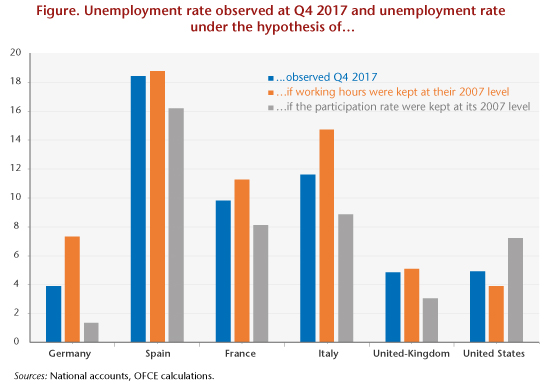By Bruno Ducoudré and Pierre Madec
In the course of the crisis, most European countries reduced actual working hours to a greater or lesser extent through partial unemployment schemes, the reduction of overtime or the use of time savings accounts, but also through the expansion of part-time work (particularly in Italy and Spain), including on an involuntary basis. In contrast, the favourable trend in US unemployment has been due in part to a significant fall in the labour force participation rate.
Assuming that a one-point increase in the participation rate leads, holding employment constant, to a rise in the unemployment rate, it is possible to measure the impact of these adjustments (working hours and participation rates) on unemployment by calculating an unemployment rate at constant employment and checking these adjustments. Except in the United States, the countries studied experienced an increase in their active population (employed + unemployed) that was larger than that observed in the general population, due among other things to the implementation of pension reforms. Mechanically, without job creation, this demographic growth would have the effect of pushing up the unemployment rate in the countries concerned.
If the participation rate had remained at its 2007 level, the unemployment rate would be lower by 2.3 points in France, 3.1 points in Italy and 2 points in the United Kingdom (see figure). On the other hand, without the sharp contraction in the US labour force, the unemployment rate would have been more than 3.2 percentage points higher than that observed at the end of 2017. It also seems that Germany has experienced a significant reduction in its unemployment rate since the crisis, even as its participation rate rose. Given the same participation rate, Germany’s unemployment rate would be … 0.9%. However, changes in participation rates are also the result of structural demographic factors, to such an extent that the hypothesis of a return to 2007 rates can be considered arbitrary. For the United States, part of the fall in the participation rate can be explained by changes in the structure of the population. The figure for under-employment can also be considered too high.
The lessons are very different with respect to the duration of work. It seems that if working hours had stayed at their pre-crisis levels in all the countries, the unemployment rate would have been 3.7 points higher in Germany and 2.9 points higher in Italy. In France, Spain, the United Kingdom and the United States, working time has fallen only slightly since the crisis. If working hours had remained the same as in 2007, the unemployment rate would have been slightly higher in all of these countries.
Note that the trend for working time to fall largely preceded the 2007 economic crisis (table). While this pre-crisis trend has continued in Germany and even been accentuated in Italy, working time has fallen to a lesser extent in France, Spain and the United States. In the United Kingdom, the reduction in working hours that was underway before 2007 has been cut short.


Leave a Reply